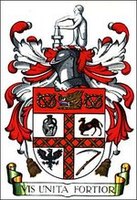Stoke-on-Trent
| City of Stoke-on-Trent | ||
|---|---|---|
|
Coat of arms with inscription - VIS UNITA FORTIOR - ( united strength is stronger ) |
||
| Coordinates | 53 ° 0 ′ N , 2 ° 11 ′ W | |
| OS National Grid | SP066868 | |
|
|
||
| Residents | 255,833 (as of June 30, 2018) | |
| surface | 93.45 km² (36.08 mi² ) | |
| Population density: | 2738 inhabitants per km² | |
| administration | ||
| ZIP code section | ST | |
| prefix | 01782 | |
| Part of the country | England | |
| region | West Midlands | |
| Ceremonial county | Staffordshire | |
| ONS code | 00GL | |
| Website: stoke.gov.uk | ||
Stoke-on-Trent ( [ stəʊk ɒn trɛnt ] , usually Stoke for short ) is a city in the English Midlands ( Staffordshire ). It emerged in the early 20th century from the merger of six parishes, hence the name of the city as The Six Towns ( The Six Villages ). It is also the home of the English pottery industry and so also known as The Potteries ( The potteries ).
geography
Stoke is a short distance from several major cities in Northern England such as Manchester , Birmingham , Leicester , Nottingham , Liverpool and Sheffield . Her name was transferred from the municipality of Stoke-upon-Trent, which was attached to her. The suffix on-Trent or upon-Trent refers to the nearby river - Trent , as is customary in many British cities ; The more detailed description of the place usually serves to avoid confusion in the case of multiple city names (comparable to German names such as Frankfurt am Main , Rothenburg ob der Tauber or Freiburg im Breisgau ).
Together with the neighboring boroughs of Newcastle-under-Lyme and the Staffordshire Moorlands , it forms the North Staffordshire region with around 470,000 inhabitants (as of 2011). Stoke-on-Trent and Newcastle-under-Lyme with around 350,000 inhabitants are grouped together as The Potteries Urban Area , while the moorlands, which are significantly larger in area, are more rural and less densely populated.
Stoke-on-Trent is a polycentric community. Although the city was named after Stoke-upon-Trent and both the town hall and the main train station are located there, the actual city center is in Hanley .
history
The area has been known for pottery since the 17th century . Well-known brands such as Spode, Royal Doulton , Wedgwood and Minton were located here. Even today, blackened brick buildings bear witness to this past. The history of this industry is kept alive by the Gladstone Pottery Museum , an anchor point on the European Route of Industrial Heritage (ERIH).
The economic development of the pottery was also shaped by the construction of the Trent and Mersey Canal , a so-called Narrowboat Canal . This was the first available transport route for bulk goods in the context of the industrial revolution . Today's urban area developed into a region of coal mines and iron works . The Shelton Bar steel mill in Hanley was considered one of the most modern in England in the third quarter of the 19th century.
In 1910, the Six Towns Federation merged the districts of Hanley, Burslem, Longton and Stoke-upon-Trent with the districts of Tunstall and Fenton as a common county of Stoke-on-Trent. In 1925 the community received city status.
The town's self-governing county status was revoked in 1974 and the town became part of Staffordshire . On April 1, 1998, Stoke-on-Trent returned to its function as an independent city district ( Unitary Authority ), but still belongs to the county.
The deindustrialization of the United Kingdom, particularly pushed by Margaret Thatcher, had a particularly strong impact in Stoke. In 1994 the last mine, the Trentham Superpit (a merger of the collieries Hem Heath , Stafford Collieries and Florence Collieries ) was closed, the last rolling mill in 2002.
economy
In the fourth quarter of the 20th century, the ceramics industry closed one by one. As a result, unemployment in the Potteries region rose noticeably. Today most of the workforce is employed in the tertiary sector (service sector). Some companies in the ceramics industry switched from producing ceramics to trading in imported goods.
politics
Unlike most English cities, the city is governed by a directly elected mayor.
When the UK left the EU ( Brexit ) in 2016, almost 70% of Stoke-on-Trent's eligible voters voted for Brexit.
The coat of arms of the city contains the motto of the county district Vis Unita Fortior as an inscription (for example: united strength is stronger , analogously: unity means strength ).
sons and daughters of the town
Football clubs
Town twinning
Web links
Individual evidence
- ↑ Mid 2018 Estimates of the population for the UK, England and Wales, Scotland and Northern Ireland
- ^ Minerals in the City of Stoke-on-Trent , accessed July 19, 2018.
- ↑ Population of England and Wales on June 30, 2012 ( ZIP ; 832 kB)
- ↑ Samuel Griffiths: Griffiths's Guide to the Iron Trade of Great Britain . London 1873, p. 117.
- ^ A b Karl-Heinz Büschemann, Björn Finke: Stoke-on-Trent… a visit to a city whose people were very proud of their industry. But then the decline began. In: Süddeutsche Zeitung of July 2, 2016, p. 34.
- ^ The Guardian
- ↑ Facts and figures about Stoke-on-Trent

